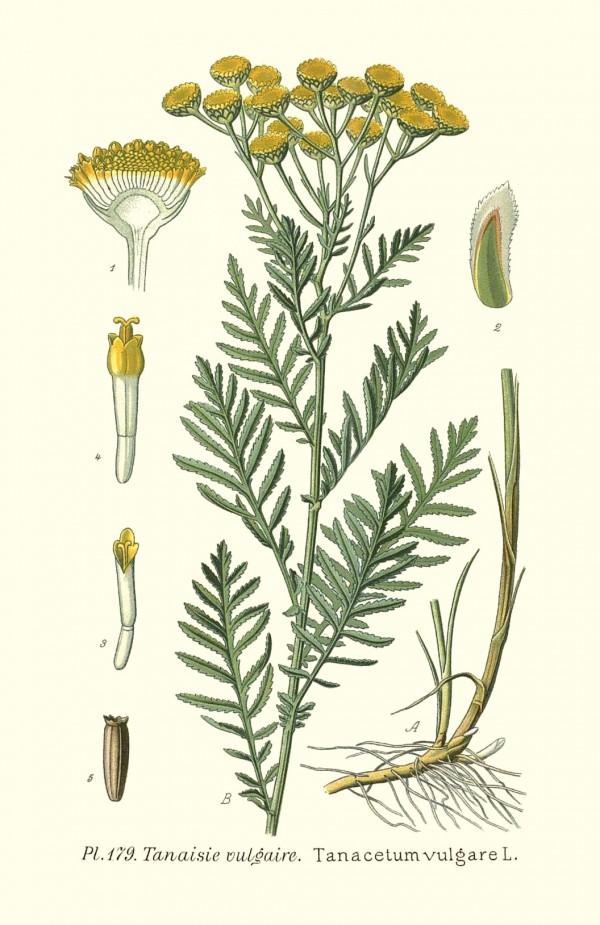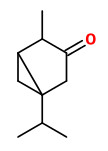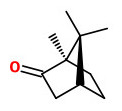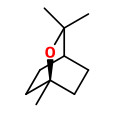Tanacetum vulgare L. - syn.Chrysanthemum vulgare (L.) Bernh. - Asteraceae - tansy, golden buttons, Rainfarn
Perennial herb, 0.40-1.50m high, native to Eurasia; leaves bipinnately divided, leaflets serrulate; flower heads 1cm across, without ray florets, disc florets yellow.
Of tansy genotypes from Finland, 15 were well defined and five were mixed chemotypes. The most frequently found monoterpene in pentane extracts of the flowerheads was camphor, other compounds were camphene, 1,8-cineole, pinocamphone, chrysanthenyl acetate, bornyl acetate and isobornyl acetate. In 13 genotypes, camphor concentration exceeded 18.5% and in seven genotypes, camphor was less than 7.2%. Other chemotypes were rich in trans thujone, artemisia ketone, 1,8-cineole, or davanone-D.
[Variation in volatile compounds from tansy (Tanacetum vulgare L.) related to genetic and morphological differences of genotypes., Keskitalo, M., Pehu, E., Simon, J.E., Biochemical Systematics and Ecology, 29(3), 2001, 267-285]
The essential oil yield from plants grown in Norway „…ranged between 0.35 and 1.90% (v/w) (average: 0.81%); the most abundant thujone plants were especially rich in EO volatiles (0.95%). On the basis of GC-MS data, seven chemotypes could be identified as follows: A, α-thujone (two individuals); B, β-thujone (22); C, camphor (six); D, chrysanthenyl acetate/chrysanthenol (three); E, chrysanthenone (two); F, artemisia ketone/artemisia alcohol (three); and G, 1,8-cineole (two). The thujone chemotype was dominated by β-thujone (81%) associated with α-thujone, but tansy plants rich in α-thujone were also detected (61%).“
[Chemotypical variation of Tansy (Tanacetum vulgare L.) from 40 different locations in Norway., Rohloff, J., Mordal, R., Dragland, S., Journal of agricultural and food chemistry, 52(6), 2004, 1742-1748]
„Several chemotypes of tansy exist, differing in the composition of their volatile oil (α-thujone, β-thujone, camphor-type etc.)… Tansy has proven anthelmintic, antimicrobial and choleretic activities that are confirmed in human studies. The sesquiterpene lactones may cause allergic reactions, while thujone is a known neurotoxin. The oil (and thujone) may cause abortion, vomitting, abdominal pain, rapid brathing, rapid heart beat, loss of consciousness and death.“
[Medicinal Plants of the World. Ben-Erik Van Wyk and Michael Wink, Pretoria 2004, 99]
„This article reports the results concerning the qualitative and quantitative composition of the volatile oil obtained from the aerial parts of Tanacetum vulgare, collected in Lithuania, by supercritical fluid extraction (SFE) with CO2 at 90 bar and 40 °C and by hydrodistillation (HD). GC-MS and GC-FID analysis revealed that the oils mainly consisted of 1,8-cineole, trans-thujone, cis-chrysanthenol, borneol and myrtenol. Oils obtained by HD displayed, with respect to the SFE volatile oil, a higher amount of hydrocarbon monoterpenes. The hydrodistilled oil was particularly active against dermatophyte strains and Cryptococcus neoformans, with MIC values in the range of 0.16-0.64 μL/mL. The oil revealed a significant inhibitory effect on germ tube formation in Candida albicans at sub-inhibitory concentrations. At the concentration of 1/16 MIC, the inhibition of filamentation was more than 80% in comparison to untreated control cells.“
[Chemical composition and antifungal activity of supercritical extract and essential oil of Tanacetum vulgare growing wild in Lithuania., Piras, A., Falconieri, D., Bagdonaite, E., Maxia, A., Gonçalves, M. J., Cavaleiro, C., Porcedda, S., Natural product research, Vol.28(21), 2014, 1906-1909]
„Variations in the essential oil content and composition in aerial parts of two tansy samples from different districts of Estonia were determined using hydrodistillation, GC and GC-MS techniques. The yields of the two oil samples were 0.4 and 0.5 % (w/w). Total 83 compounds identified in both the oils made up 98.4 % of each oil. The most important quantitative components in tansy oil from Harju district were trans-chrysanthenone (41.4 %), 1,8-cineole (9.6 %), β-pinene (6.5 %), α-pinene (5.0 %) and 6-camphenone (4.6 %). In the oil from Tartu district, β-thujone (47.2 %) and trans-chrysanthenyl acetate (30.7 %) predominated. Thus analyses results in assigning the Tanacetum vulgare of Harju and Tartu district as trans-chrysanthenone and β-thujone-trans-chrysanthenyl acetate chemotypes. For the first time, the β-thujone-trans-chrysanthenyl acetate chemotype was determined.“
[Essential Oil Content and Composition in Tanacetum vulgare L. Herbs Growing Wild in Estonia., Raal, A., Orav, A., Gretchushnikova, T., Journal of Essential Oil Bearing Plants, Vol.17(4), 2014, 670-675]

Masclef, A., Atlas des plantes de France, vol. 2: t. 179
http://plantgenera.org/species.php?id_species=996707
Tanacetum vulgare
© Rolf Marschner (2008),
www.botanische-spaziergaenge.at



